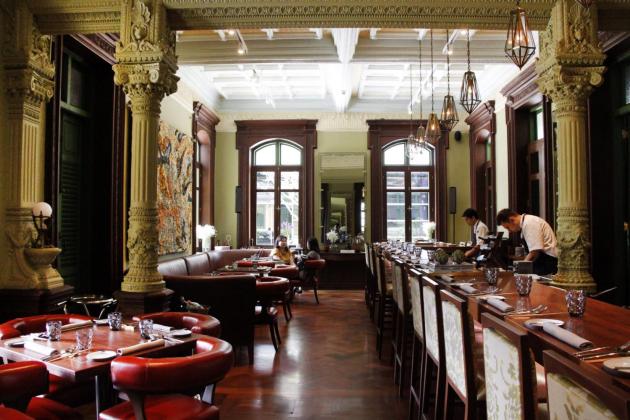The tastiest of travelogues

Fatih Tutak, chef at The House on Sathorn's dining room, shares wonderful memories of his journey in every enticing dish
THE DINING Room at the impressively refurbished the House on Sathorn gives its swank dishes some of the most interesting names ever to come out of a kitchen. Matching the dishes themselves in terms of creativity, they include “On My Way Home to Silom” and “Early Morning at Tsukiji Market”.
Three years of restoration have given a 126-year-old colonial mansion a whole new life, as reflected in the culinary works of art conceived by the chef, Fatih Tutak, a well-travelled Turk.
From his open kitchen with a long counter and seats from which to watch him work, he might start your meal with something of a memento. The dish called From My Childhood (Bt350) features grilled eggplant topped with eggplant puree and grilled okra dressed with edible flowers covered with a sheen of tomato (made with tomato consomme and gelatin).
“In Turkey we have over 600 kinds of eggplant,” says Tutak, who’s been in Thailand for eight months. “My mum cooked eggplant dishes two or three times a week, and her home cooking is what inspired my interest in cooking at a young age. She always has fresh flowers in the kitchen, which is why I created this dish with edible flowers. I use kamo, a seedless eggplant from Japan, but the flavour and texture are similar to Turkish eggplant.”
The House on Sathorn adjoins the W Hotel at the Sathorn-Narathiwas intersection and is indeed run by the same people. The building, erected in 1889, was originally the residence of wealthy businessman Luang Sathorn Rajayutka, who had the Sathorn Canal dug to transport goods through the city. By the early 1920s his house had become the Hotel Royal, and from 1948 to 1999 it served as the Soviet, then the Russian, embassy.
The old mansion is actually owned by the Crown Property Bureau, so the hotel undertook the renovations in close consultation with the government’s Fine Arts Department, ensuring fidelity to the original structure, right down to the tones in the woodwork. The intricate wooden staircases remain intact, as does the ornate Rajayutka family fresco, all meticulously restored. Modern elements including contemporary Thai tapestries, paintings, photographs and sculptures were added under the direction of New York design firm AvroKO.
The House on Sathorn has the Bar, the Courtyard for outdoor dining, and will soon open the Upstairs, a club lounge with music, and four hospitality suites and private dining and meetings. But it’s the Dining Room, with its “artisanal Asian-inspired cuisine”, that’s getting most of the attention right now.
Chef Tutak has lived and worked in Denmark, Japan, Singapore and Hong Kong and in mainland China, several of those stints being at Michelin-star restaurants. “All the dishes here have stories behind them,” he says. “The ingredients are what I like to eat and what I see on the streets, but all the dishes come from moments in my life that I never forgot, just like the long history of the House.”
The platter called Early Morning at Tsukiji Market (Bt625) is a paean to the pre-dawn fish auctions at that huge wholesale market in Tokyo. It is 100 grams of raw blue-fin tuna fillet from the market marinated in soy sauce, mirin and sake, lightly sprinkled with sudachi lime and garnished with shiso buds. On one side of the plate is pureed avocado, and on the other roasted, powdered seaweed.
Then there was Tutak’s Christmas dinner in Hong Kong, vividly recalled in another appetiser, Red Parfait (Bt750). This is foie gras terrine encased in beetroot jelly with 10-year-old balsamic vinegar on the side and a fresh-baked brioche.
Char Siu (Bt550) replaces the barbecued pork belly that’s traditional in Hong Kong with charcoal-grilled Kurobuta pork skirts, presenting them in red-amber barbecue sauce with Hong Kong kale and dried shredded pork.
Indian Accent (Bt300) was conceived on a visit to Mumbai. It comprises three layers of cauliflower – pureed, pan-fried with curry, and dehydrated – tossed with madras curry, cashew nuts and raisins. On the side is hung yoghurt, naturally thick and popular in Indian desserts.
Some diners might balk at the dish called Hunting, but there’s no denying the imagination behind it. Tutak used to shoot wild duck in Germany, and here we have breast of Challans duck (Bt790), charcoal-grilled until medium-rare and splattered with “blood”. It’s only pomegranate sauce, though, the better with which to enjoy the onions that come with it, sliced into spaghetti-like strings and sprinkled with onion charcoal powder and fresh sorrel leaves.
Next the chef was off to Phuket, returning with the idea for Pier 9 (Bt1,350), a hefty charcoal-grilled river prawn (that actually comes from Ayutthaya) in a sauce of cheddar, cream and prawn fat. The not-so-shrimpy shrimp’s head is also stuffed with prawn flesh and fat, along with Thai basil, lemongrass, chilli and kaffir lime. On the side is kabocha – pureed Japanese pumpkin – and on top dry pumpkin chips and Thai sweet basil.
The meal proper ends as it should, with On My Way Home to Silom (Bt350), which is where Tutak every day sees vendors grilling bananas. Served in a banana leaf, his grilled banana is laced in caramel sauce and topped with banana “snow” – a mousse mixed with liquid nitrogen and blended into powder.
For the finale, No Cheese Cake (Bt350) is lovely and light, made with sake kasu, the lees left over from sake production. Kasu gives the dessert the flavour of fermented rice.
AROUND THE WORLD
>>The Dining Room at the House on Sathorn is open daily for lunch, noon to 2.30, and for dinner, 6 to 10.30.
>>Book a table at (02) 344 4000 or www.TheHouseOnSathorn.com.
RELATED





